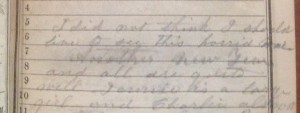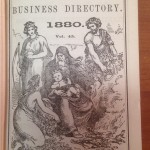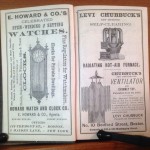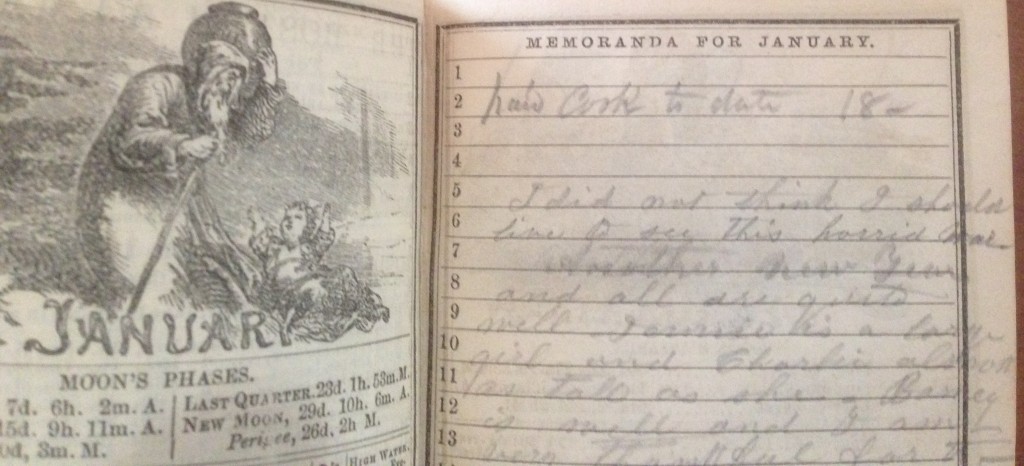[Editor’s Note: Orion’s Attic obtained an exceptional group of rare books — three editions of the Boston Almanac for the years 1862, 1863 and 1880. I had no idea that they would take me on an emotional journey. Following is the story these three volumes have to tell. They are now available in the Books department of our eBay store, which you can always access at OrionsAttic.com.]
I did some more time traveling this week, going back to Boston early in the Civil War and hanging out there through 1880. I even met a woman whose name I still do not know, a woman I can’t stop wondering about.
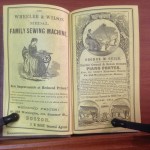 Boston in 1862 was filled with tension. Business leaders like everyone else were frightened by the onset of what Boston Almanac for 1862 editor George Coolidge called “the Great Rebellion.” The name of the war, of course, depended on whose side you were on. Traditionally a a straight-forward business directory, the 1862 version is filled with ads. I peruse yellow-tinted advertisements for Chilson’s Double Oven Cooking Range, Davis’s Hot-Air Radiator, Oak Hall Cloths and Clothing, Wheeler & Wilson Medal Family Sewing Machine, Hunnewell’s Eclectic Pills and so many more products and companies.
Boston in 1862 was filled with tension. Business leaders like everyone else were frightened by the onset of what Boston Almanac for 1862 editor George Coolidge called “the Great Rebellion.” The name of the war, of course, depended on whose side you were on. Traditionally a a straight-forward business directory, the 1862 version is filled with ads. I peruse yellow-tinted advertisements for Chilson’s Double Oven Cooking Range, Davis’s Hot-Air Radiator, Oak Hall Cloths and Clothing, Wheeler & Wilson Medal Family Sewing Machine, Hunnewell’s Eclectic Pills and so many more products and companies.
Coolidge’s introduction of the 1862 almanac, though, turns grim quickly — painting a scene of tension about the economic challenges of publishing it at the onset of the war. He extols the virtue of listing New England soldiers’ (volunteers) names and towns for posterity:
At the time of the outbreak of the rebellion, in April last, it became necessary to decide what plan to pursue in the compilation of the Almanac. The General Business Directory, which had always formed so important a part of the book, would not save it from the destruction which threatened to overwhelm all business pursuits. The advertising interest could not be relied on, as before, for support. No profits accrue from sales at the low price for which the book is sold. Should the publication be abandoned, or suspended, or issued at the risk of serious loss? It was decided to make the Almanac the interesting record of the Great Rebellion that it is now, keeping the price of it the same as before, and to trust it as a ship cast upon stormy seas. It could at least convey to other times the roles of those honorable man who sprang to the defense of our national liberty at the instant of its assault.
To the Governors of the New England States, and the correspondents who have assisted in the severe labor of the compilation, the subscriber returns his thanks, regretting the inevitable errors that must always arise from repeated copyings of names, which may deprive some worthy soldiers of their due standing in our work for the aged in which we live. A supplement to the present number, or the Almanac for another year, will contain the needful continuation of the military department, with corrections of the present list, notes of casualties, etc.
The Table of Contents identifies subjects of the book including: Index to Advertising Department, Chronicle of Events, Eclipses, etc., Calendar and Memoranda Pages, U.S. government, U.S. Census, U.S. Navy, U.S. Army, New England volunteers, the recruiting system, Massachusetts State Government, County Officers, Sessions of Courts, Municipal Register, Post Office, Customhouse, Advertising Department, Tinted Leaves. (Did the yellow tinting of pages in almanacs like these lead to the Yellow Pages of today?)
A chronicle of events from 1859 to 1861 follows after that, leading to a calendar section where I first meet the woman who I quickly get to know in spirit if not by name. The writing and tone of her pencil-written monthly diary notes suggest the writer is female, though I could be wrong.
“I did not think I would live to see this horrid war,” she writes in January 1862.
Wow. Hand-written notes from someone who lived through the Civil War, hidden inside rare books. I didn’t realize the Boston Almanacs had such notes in them when I bought them. This surprise fills me with joy and it’s one of the great many things I love about buying, collecting and selling rare books and antiquarian books. I am now captivated by my entry into this mystery woman’s world. She adds that various members of what I presume are her family are doing well. This includes a young girl and her brother “Charlie,” who will also set my mind to wondering through the course of the other editions of the Almanacs. She makes note of a few people that she paid. The family builds a new room in September. Little else is mentioned for that year.
Coolidge speaks up again at the introduction on the section about New England’s volunteer soldiers: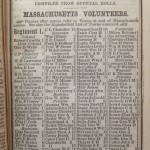
We have the most entire confidence that the public will fully appreciate our labors in their behalf in the introduction of this new feature of the Almanac, so appropriate at the present time, and trust that the cheapness and utility of the work was so commended it to the favor and patronage of all, that there will be few, if any, New England families that will deny themselves the opportunity of having always at hand a full and complete list of the companies in arms of their fathers, husbands, brothers, and sons, who have gone forth with their benedictions from happy homes to fight the battles of freedom and humanity, to crush the rebellion, re-establish the authority of Republican institutions, and restore the supremacy of law.
The Boston Almanac for 1863 picks up where Coolidge left off — answering the question of how the previous edition performed as it was launched in war time. Turns out the edition did just fine. Coolidge reports the results and again rails against the immoral intent of the South:
The course pursued in the compilation of the Boston Almanac for 1862, and making it a Military Record of the times, proved highly successful, having increased the sale 5000 copies. The Business Directory, which for more than twenty years has been the principal picture of the Almanac, has been issued in a new form, as noticed on the opposite page.
The article on Internal Revenue will be found of the greatest interest and importance to all Business persons, in supplying information which has been sought by letters and delegations to Washington for several months. It is received from sources that render it entirely reliable, and is probably obtainable and no other published compilation. …
In the Lists of Massachusetts Volunteers are nearly 40,000 names of those who have gallantly responded to the call of their country during the past year. The reader is referred to page 308, for information respecting Supplements to the Boston Almanac, designed to chronicle the movements and heroic achievements of the valiant sons of New England, and the complete overthrow of the existing rebellion, – that great crime against humanity, as godless as it is in human. Make the remaining moiety of the military power of the United States be equally ready to battle the enemies of the country, to the last man and the last dollar. Better that the free people of the North be blotted from existence, then this world-wide effort of privilege classes succeed, in its based assault on the common rights of mankind, however specious the guise it may assume in accomplishing its infamous ends.
Contents of the Boston almanac 1863 include Events of 1862, Calendar and Memoranda Pages, Internal Revenue, Post Office, U.S. Government, Custom Boston house, City Government, Courts in Boston, State Government, New Congressional Districts of Massachusetts, and Members Elected, County Officers, Sessions of Courts, Massachusetts Volunteers, Town Localities of the Volunteers, Tables of Population, Enrollments, Quotas etc. of the Cities and Towns in Massachusetts, Perspectives of Supplements to the Boston almanac, and Advertising Directory.
Sadly, my diarist friend makes not a note in 1863. I do not meet her again for 17 years – in Boston Almanac and Business Directory for 1880. The Civil War is now in the rear view mirror of Boston as it gallops toward the 20th century. Rutherford B. Hayes is the U.S. president. Frederick O. Prince is the Boston mayor. Editor George Coolidge is no longer listed on the publication and there is no gripping introduction relating to the tragedy of the Civil War. The Boston Almanac in 1880 is all business.
Ads hock Fairbanks’ Scales, S.H. Sandborn Bookbinder, The Rising Sun Stove Polish, Chickering Pianos, E. Howard & Co’s Celebrated Stem-Winding and Setting Watches and many more companies and products.
The index of contents is expanded, as is the book. The size is larger, now almost 5.5 inches tall, and the pages have increased to the 500s. Contents include subjects such as assessors, banks, births in Boston, Boston, Board of agriculture, Board of Education, Board of Health, Lunacy, etc., Boston city debt, bridges, cemeteries, clergymen, constables, fire department, gas light companies, Grand Army of the Republic, hack fares, Knights of Honor, Knights of the Pythias, lawyers, libraries, Masonic, Odd Fellows, police, population of cities in the U.S., public baths, Soldiers’ Messenger Corps, steamers, temperance societies, theaters, wharves and much more.
The diarist returns in January of 1880. I can’t even imagine what she has experienced since 1862 through the Civil War and beyond. For the month of January, she appears to write that another New Year’s has come and that she wishes her children were back in childhood again (if I’m reading that note correctly). In February, she notes that “Charlie gave me one of his books and I am really proud of him.” She also reports that it has been a mild winter with scarcely any snow.
In June, she writes that “Charlie’s book of birds of the world just came out.” I wonder who is this Charlie and what was his book? Was he the author? Publisher? It certainly has to be a rare book now and this rare book dealer would love to hold a copy. I search databases for rare books about birds published around 1880 but turn up nothing that looks like it could be from this Charlie. And what happened to his sister? Why is she not mentioned? Did something happen to her as a child? Did she die?
August comes. The woman may have gone to New York and may also have received “splendid letters” from Charlie. Again, cursive written with pencil from a bygone era is hard to read. On the down side, Charlie appears to be sick in Paris. The woman is thankful for a doctor whose name I can’t quite make out.
Charlie sails home in September, the same month that the woman writes that the city of Boston celebrated its 250th anniversary.
Mention of the sister, Jeannie could possibly be her name, comes again in October. I’m relieved. She’s alive and apparently well. The woman writes about her again in December along with perhaps another son whose name starts with a B that is mentioned a few times. The woman’s very last note is on the line for December 31, 1880. “Charlie’s Birthday.”
The woman disappears from my life and all is quiet on the streets of Boston in 1880. Only the sound of her pencil scratching its way across almanac pages fills the air.
[Do you have rare books or antiquarian books to sell or know someone who does? Orion’s Attic is always seeking to obtain more along with all kinds of other antiques and collectibles. Contact us today. We buy and consign in addition to running estate sales and providing estate liquidation services in Maryland, Washington D.C., Northern Virginia and beyond.]


